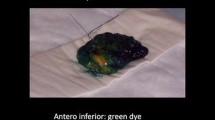Abstract
The purpose of this study was to evaluate the diagnostic utility of sonoelastography in differentiating benign from malignant non-palpable breast lesions. A total of 293 BI-RADS 3–5 (Breast Imaging Reporting And Data System) impalpable breast lesions in 278 women was evaluated with B-mode ultrasound (US) and subsequently with sonoelastography (SE) before performing US-guided biopsy. Among the 293 lesions (size up to 2 cm), 110 (37.5%) were histologically malignant and 183 (62.5%) benign. Lesions that were malignant or showed atypical ductal hyperplasia were referred for surgical excision, as well as 32 benign lesions showing discordance between US/SE results and histology. All other benign lesions had US follow-up at 6/12 months, showing stability. Overall performance of SE was lower than US, with sensitivity and specificity of 80% and 80.9%, respectively, for SE as compared with 95.4% and 87.4% for US. Statistical analysis showed no improvement in the joint use of SE and US over the use of US alone, whose performance, however, was very high in our study. SE is a simple, fast and non-invasive diagnostic method that may be a useful aid to US for less experienced radiologists in the assessment of solid non-palpable breast lesions, especially BI-RADS 3, where specificity was higher (88.7%).





Similar content being viewed by others
References
Blohmer JU, Oellinger H, Schmidt C, Hufnagl P, Felix R, Lichtenegger W (1999) Comparison of various imaging methods with particular evaluation of color Doppler sonography for planning surgery of breast tumors. Arch Gynecol Obstet 262:159–171
Schroeder RJ, Bostanjoglo M, Rademaker J, Maeurer J, Felix R (2003) Role of power Doppler techniques and ultrasound contrast enhancement in the differential diagnosis of focal breast lesions. Eur Radiol 13:68–79
Stavros AT, Thickman D, Rapp CL, Dennis MA, Parker SH, Sisney GA (1995) Solid breast nodules: use of sonography to distinguish between benign and malignant lesions. Radiology 196:123–134
Tardivon AA, Guinebretiere JM, Dromain C, Vanel D (2002) Imaging and management of nonpalpable lesions of the breast. Eur J Radiol 42:2–9
Zonderland HM, Hermans J, Coerkamp EG (2000) Ultrasound variables and their prognostic value in a population of 1,103 patients with 272 breast cancers. Eur Radiol 10:1562–1568
American College of Radiology (2003) Breast imaging reporting and data system (BI-RADS), ultrasound. 4th edn. ACR, Reston, VA. Available at: http://www.acr.org
Ophir J, Cespedes I, Ponnekanti H, Yadzi Y, Li X (1991) Elastosonography: a quantitative method for imaging the elasticity of biological tissues. Ultrason Imag 13:11–134
Garra BS, Cespedes EI, Ophir J, Spratt SR, Zuurbier RA, Magnant CM, Pennanen MF (1997) Elastography of breast lesions: initial clinical results. Radiology 202:79–86
Itoh A, Ueno E, Tohno E, Kamma H, Takahashi H, Shiina T, Yamakawa M, Matsamura T (2006) Breast disease: Clinical application of US Elastography for diagnosis. Radiology 239:341–350
Giuseppetti GM, Martegani A, Di Cioccio B, Baldassarre S (2005) Elastosonografia nella caratterizzazione delle lesioni nodulari della mammella/Elastosonography in the diagnosis of the nodular breast lesions: preliminary report. Radiol Med 110:69–76
Thomas A, Kummel S, Fritzsche F, Warm M, Ebert B, Hamm B, Fischer T (2006) Real-time sonoelastography performed in addition to B-Mode ultrasound and mammography: improved differentiation of breast lesions? Acad Radiol 13:1496–1504
Locatelli M, Rizzatto G, Aiani L, Martegani A, Baldassarre S, Giuseppetti GM, Bulzacchi A, Di Maggio C, Della Sala SW, Mangialavori G, Monno P, Lattanzio E, Scaperrotta G, Floriani I (2007) Characterization of breast lesions with real-time sonoelastography: results from the Italian Multicenter clinical trial. Eur Radiol 17(Suppl 1):200 (ECR 2007 – Book of abstracts)
Hughes LE, Mansel RE, Webster DJT (1987) Aberrations of normal development and involution (ANDI): a new perspective on pathogenesis and nomenclature of benign breast disorders. Lancet 2:1316–1319
Hanley JA, McNeil BJ (1982) The meaning and use of the area under a receiver operating characteristic (ROC) curve. Radiology 143:29–36
Hanley JA, McNeil BJ (1983) A method of comparing the areas under receiver operating characteristic curves derived from the same cases. Radiology 148:839–843
Hiltawsky KK, Kruger M, Starke C, Heuser L, Ermert H, Jensen A (2001) Freehand ultrasound elastography of breast lesions: clinical results. Ultrasound Med Biol 27:1461–1469
Konofagou EE (2004) Quo vadis elasticity imaging? Ultrasonics 42:331–336
Ueno E, Iboraki P (2004) Clinical application of US elastography in the diagnosis of breast disease. European Congress of Radiology, Vienna
Sarvazyan AP, Skovoroda AR, Emelianov SY et al (1995) Biophysical bases of elasticity imaging. Acoustical Imaging 21:223–240
Walz M, Teubner J, Georgi M et al (1993) Elasticity of benign and malignant breast lesion: imaging, application and results in clinical and general practice. 8th International Congress on the Ultrasonic Examination of the breast
Sewell CW (1995) Pathology of benign and malignant breast disorders. Radiol Clin North Am 33(6):1067–1080
Tardivon AA, Delignette A, Lemery S, Baratte B, Levy L, David P, Le Mouel A, Balu-Maestro C, Scheffer B (2006) Ultrasound elastography: results of a French multicentric prospective study about 345 breast lesions. Eur Radiol 16(Suppl 1):213
Author information
Authors and Affiliations
Corresponding author
Rights and permissions
About this article
Cite this article
Scaperrotta, G., Ferranti, C., Costa, C. et al. Role of sonoelastography in non-palpable breast lesions. Eur Radiol 18, 2381–2389 (2008). https://doi.org/10.1007/s00330-008-1032-8
Received:
Revised:
Accepted:
Published:
Issue Date:
DOI: https://doi.org/10.1007/s00330-008-1032-8




